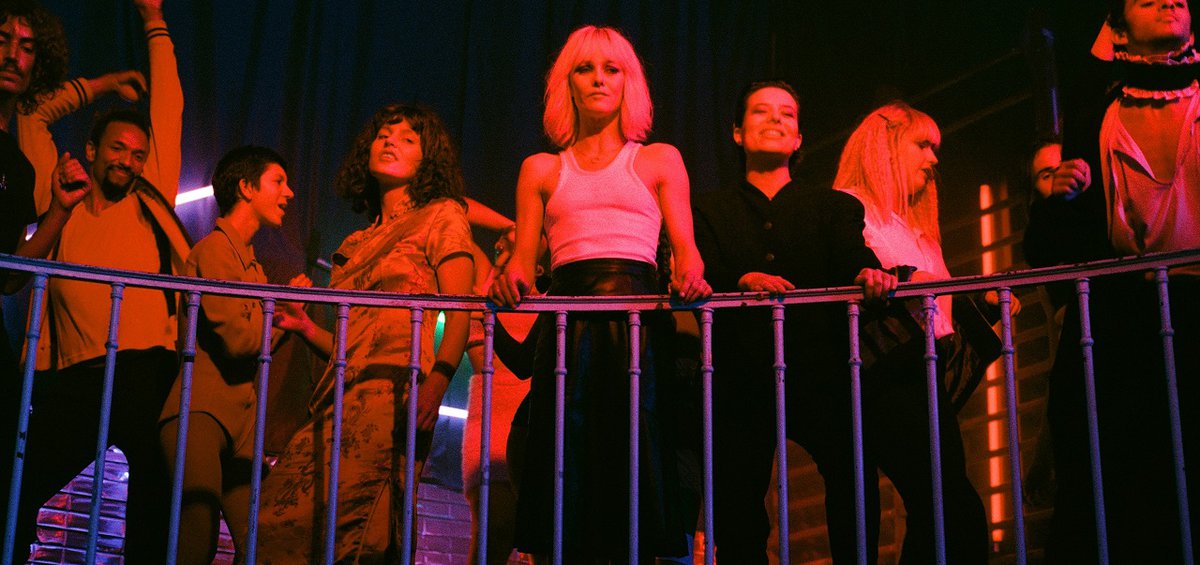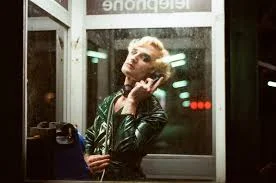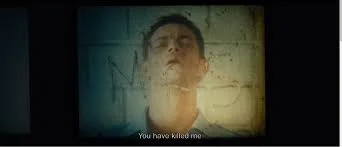Playing the Whore: A View from the Bottom
Playing the Whore: A View from the Bottom -- The Fluffer and Knife + Heart as Cinema of Obsession and Domination/submission
Playing the Whore, which takes its name from Melissa Gira Grant's book on sex work and policy Playing the Whore: The Work of Sex Work, is a new column examining and surveying queer sex work in film, from Bruce LaBruce to Chantal Akerman. Playing the Whore seeks to interrogate ideas of power, eroticism, desire, capital, artifice, performance, pornography, politics, and film.
“The menace of pornography in the eyes of public figures, religious leaders, and even committed feminists in late-twentieth- and early-twenty-first-century America lies, not in its virulently misogynistic ‘messages,’ but in its having raised the specter of emasculation. Put more tendentiously, pornography feminizes,” writes scholar and writer Andrea Long Chu in an analysis of sissy porn and a reading of Joseph-Gordon Levitt’s directorial debut Don Jon. Her ideas about how porn operates insofar as a relationship with the viewer aren’t so different from love itself. If a majority of our relationships can be easily defined by relationships of power, shifting and changing like an interchangeably amazing and awful game of hot potato, Wash Westmoreland and Richard Glatzer’s broken-hearted neo-noir The Fluffer and Yann Gonzalez’s Giallo, slasher, love letter to vintage gay porn, love story Knife + Heart takes her thesis even further, arguing porn and cinema and love are one in the same, all breaking us, the audience, down into submission. Basically, cinema, and in turn love, makes bottoms of us all.
It happens so quickly, relinquishing that control. For recent Los Angeles transplant and aspiring filmmaker Sean (Michael Cunio), a video store mistake quickly turns into obsession, and it’s the first in a series of misleading doubles, duplicates, and duplicities. He sees gay porn star Johnny Rebel (Scott Gurney) in the Men of Janus production Citizen Cum, itself a parody of Orson Welles’ tale of rise and fall from power and capital, and projects onto him the perfection that is telegraphed back at him: that he is a platonic ideal of gay maleness -- white, masculine, muscular, hung, utilitarian. Behind the camera, his “real” name is Mikey; he is stubborn, greedy, narcissistic, a cipher. His blankness on screen is what makes him the perfect gay porn performer for Men of Janus: he can be what we want, what we’re told to want. And what we want, in film and in desire, turns us into bottoms, into those that wish to give up that power.
When Mikey needs a fluffer on set, he enlists Sean, and yet Johnny Rebel never becomes more real. He remains an idea of Johnny Rebel, one paradoxically created by Sean and yet shared by other viewers. He’s Janus; friend and enemy, a man with two faces. The film opens with an excerpt from Ovid’s Metamorphoses: “…both boys and girls looked to him to make love, and yet that handsome figure of proud Narcissus had little feeling for either boys or girls.”
Sun-soaked LA never looks real, not even to Sean, who views most of it either on the tiny TV screen in his room or through the viewfinder of the BetaCam. Even in the studio, and in Sean’s fantasies, there’s plasticine sheen over everything. But the illusion is still erotic, maybe more real than it could be if it were “real,” a spell to be under. It wouldn’t be any fun if Johnny Rebel were real either, isn’t part of his power that we want to submit to nothingness, and, therefore, to become nothing? Sex and death, when Eros met Thanatos, even then it was a transactional relationship. No one knows how to talk about the desire for domination in The Fluffer or Knife + Heart, not perfectly, at least. It’s always an approximation. Unable to shake his obsession with Johnny Rebel, with desire, with the idea of love and sex, with the illusion of cinema, with allure of obsession itself, Sean says, “In my mind, I’ll always be on my knees in front of him.” Honestly, aren’t we all?
In shades of blue and red neon, Anne (Vanessa Paradis) is completing one of her gay porn shoots while in the midst of a hot and cold relationship with her editor Lois (Kate Moran) that’s about to be severed for good. The body of one of her stars, an angelic twink with golden locks, turns up, and she mines the investigation of the death as inspiration for her next film Anal Fury (which is later retitled Homo-cidal), and soon her cast and crew are being killed off one by one by a mysterious murderer whose mask resembles the headpiece of a bondage suit.
In Chu’s essay, she quips, “The political lesson of pornography is this: We mostly just like what we like, whether we like it or not.” I think we like two things: artifice and submission. They’re not so different. Artifice is so often connoted with badness, that the unnatural is a lie, that the construction is devoid of depth. But really, in artifice, and within the artifice of porn, the truth is staring right back at you. Knife + Heart plays with the artifice not only of genre and not only of porn, but the ways in which the two mutate and merge, how porn can drag itself up in the performance of murder mystery or hippie film. It can mimic the grammar of another kind of cinema, transform into that cinema. Its faker reveals the base truths of our desires, contradictory and untamed. And when porn successfully performs as something other than itself, a kind of disguise, we are at its will, no? Which is to say, we are at cinema’s beck and call? While under interrogation by the police investigating the murder of the angelic twink Karl, she says, “When you lose yourself with another person, you lose control. It’s a form of love.” And for Gonzalez, love and cinema are the same thing.
Cinema becomes a kind of apparatus through which Anne can both unpack her unconscious desires and to construct a revisionist version of her life as a form of love letter. She is as much audience as she is creator in this case, her porn both fantasy and perverted, but not untrue reality. Her porno films become expressions of whom she wants to be, how she wants her life to play out, how to extract trauma from murder and find playfulness and camp. As a sort of nesting doll of genres -- a murder mystery inside of a gay porno inside of a neo-Giallo -- Knife + Heart presents cinema and porn as interchangeable two-way mirrors to truth and trauma: to see through something and yet see yourself reflected back. Perhaps it’s this that appeals most to Anne, why the power to control fantasy and yet lose yourself in that fantasy led her to Lois, who, as editor, can sit on the dock and slow down a look of pleasure or of recognition or of pain.
The ultimate fantasy in porn is to be able to control pleasure without limits, for passion itself to be a limitless experience. Steven Marcus coined the term “pornutopia” in The Other Victorians: A Study of Sexuality and Pornography in Mid-nineteenth-century England, in which the landscape is filled with people who are always sexually available. These fantasies, even at their most transgressive within Knife + Heart suggest that total control is the same as a loss of control. If cinema is not necessarily predicated on explicit sexual availability, nonetheless, we expect the characters to predicate their actions either on our expectations or beyond them, and when they do, we are enthralled. Cinema is a medium about manipulation, the breaking down of the audience to feel things. Even when it becomes a monster and eats you up.
The deliciously nasty and cruel suggestion in Knife + Heart is (jokingly) that we are, in some ways, complicit in our own exploitation, that to be exploited is the greatest form of pleasure. Even with shitty rates, the porn stars of Anne’s film work with her, killer on the loose notwithstanding. To experience the consequences of exploitation, as either victim or perpetrator, is euphoric, transcendent. To be exploited is to submit is to cum.
Beneath the pulsating verve of M83’s score (Gonzalez is the brother of M83 member Anthony Gonzalez) and the De Palma-esque playfulness with meta-cinema (scenes of scenes being filmed, movies being made, shots being spliced) is visceral heartbreak and fear. So tormented by the dissolution of her relationship with Lois, she carves with a knife into a thread of 16mm film: “You have killed me.” The crudely written words appear atop one of her actors, Thierry, receiving oral sex, recalling the phantasmagorical power of Andy Warhol’s Blow Job. The movies Anne is making are no longer for herself, they are a part of her for someone else, the control she exerts in making them ultimately relinquished to be under the scrutiny of others, specifically Anne. Gonzalez pushes into Paradis’ face to see how love has made a sub of her, her hair wreathed in bleach blonde like a negative image version of Louise Brooks or a proto-Lady Gaga. There’s even a loving quality to the kills; Gonzalez unearths the eroticism in murder, campily turning a phallus into a literal murder weapon. Yet, paradoxically, there is tenderness beneath the mask, expressive eyes and a hungry mouth, a sort of Phantom of the Porno of sorts. In all iterations of Gaston Leroux’s pulpy story, characters crumble at the ephemeral power of art, on their knees with an inability to control it or themselves.
What exists somewhat paradoxically in this equation, within the reversal of reversal of genre and artifice and medium, is extremely personal and ironically empowering. The end of the film sees the killer up on stage, the artifact that triggered his trauma and the heart he, too, had decimated years earlier projected onto him as he stands before an audience and in front of the screen at a scummy porno theater. To see ourselves on screen, to see queerness, marginalization, submission or, in effect, a kind of bottoming in cinema is a bizarre double edged sword, something that is craved and yet carries with it baggage and the weight of history. In spite of its theoretical utility, Knife + Heart’s genre play is the best way to be direct about the emotion encased within its frames: it allows the film to reach the euphoric heights and tragic melancholic abysses in its melodrama, the fear of abandonment in its twists and turns and refusals to answer, and the thrill of relinquished control in grammar of erotic imagery.
But what’s striking about Knife + Heart is not only how it positions the film itself, and cinema more broadly, as a kind of dom or top, but how it positions its audience as its sub and bottom. In a Barthesian vein, the audience is left waiting, hungry for revelations to absurd twists and answers to unseemly, possibly life altering questions. For Knife + Heart to be affecting, for any film or any love, it has to pierce beneath the skin, penetrate, if you will. We are the lover, waiting, wanting, ecstatic.
The transliteration of the French title, Un couteau dans le coeur, is A Knife in the Heart, again suggesting a kind of penetration, a willful play of power dynamics between dominance and submission. The film unleashes a fantasy of cinema as porn, porn as cinema, artifice as truth, and love and cinema as being the ultimate doms. And, as Chu says in an interview with Sean Santiago in Cakeboy, “The classic problem of the bottom is that, ideally, you should never have to consent to anything. Ideally, it just happens to you the way you want it.” The Fluffer and Knife + Heart leave you begging for more.
Bio:
Kyle Turner is a freelance writer based in Brooklyn, NY. He is a contributor to Paste Magazine, and his work has been featured in The New York Times, The Village Voice, Playboy, Brooklyn Magazine, Slate, and Esquire. His work focuses on identity and issues of queerness and race. He is relieved to know that he is not a golem.
Twitter: @TyleKurner















